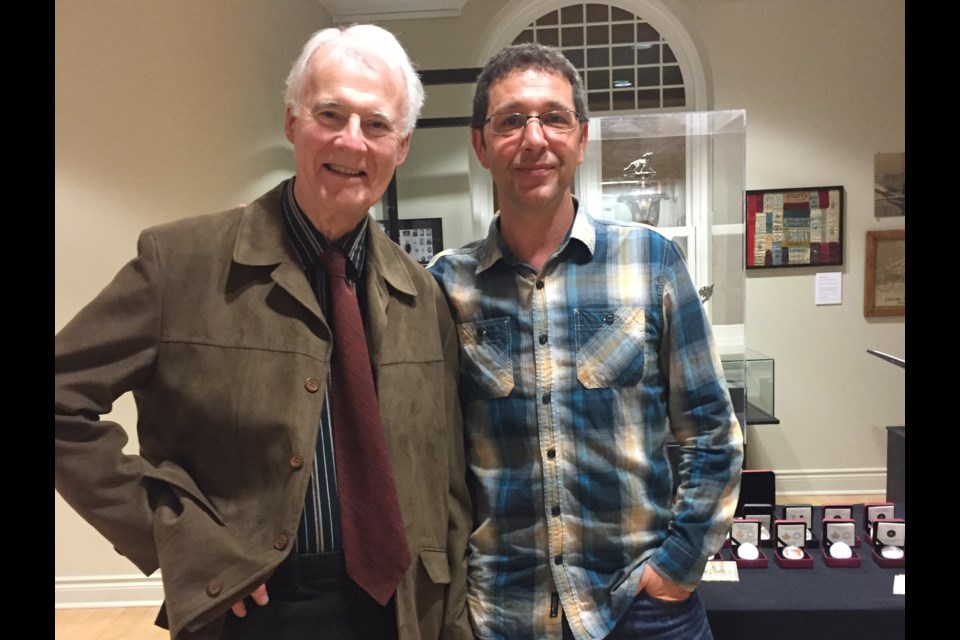NEWS RELEASE
ORILLIA MUSEUM OF ART & HISTORY
********************
The Carmichael Art History Lecture at the Orillia Museum of Art & History (OMAH) on May 8 began with retired architect Robert Browne paying loving tribute to his late wife, Qennefer Browne, who initiated the Carmichael Lecture over a decade ago.
Bob then introduced “The Life of Emanuel Hahn,” a 16 mm black and white film produced by the Canadian Broadcasting Corporation in the 1950s.
He explained that the film, which also featured a young and vibrant Qennefer providing insight into her parents’ personal and professional life, was recovered and restored by the Canadian Numismatic Association after the CBC discarded it.
The film displays Hahn’s affection for the outdoors and his country in works including geese, beaver, moose, Inuit children and explorer Vilhjalmur Stefansson. It notes that he was a high school dropout before becoming a renowned sculptor.
Hahn designed a number of Canadian coins, including the Caribou Quarter, the Bluenose Schooner Dime, the 1935 Silver Jubilee Silver Dollar and the 1939 Royal Visit Silver Dollar. He also designed a number of Canadian postage stamps dealing with wildlife, memorials, monuments and utilitarian headstones.
Hahn’s study of an Indigenous Warrior is displayed at the National Art Gallery in Ottawa. He also loved to sculpt religious figures and headstones.
His wife (and Qennefer’s mother), the late Elizabeth Wynn Wood, was a renowned sculptress in her own right. She is also immortalized in one of his works displayed at the National Art Gallery.
“For sale: baby shoes. Never worn.” The lore is that Ernest Hemingway used this phrase to win a bet with his friends to see who could write the best six-word story.
Master coin artist Tony Bianco shared this analogy to explain his measure of noteworthy coin art design to the attentive audience.
Bianco has designed over 100 Canadian coins for the Royal Canadian Mint. Bianco’s coins are elegant and powerful and sometimes playful. They come in all sizes, metals and denominations as could be seen in the array of money on view at the lecture.
He explained that all artists are storytellers and, if a story is well told or resonates with people, they will appreciate it.
Bianco elucidated that art is limited by its frame or in the case of a coin, by the restrictions of a half-inch or sometimes smaller pieces of metal. He critiqued examples of his own Canadian coins and explained how some coins successfully told a story, while a few others did not resonate with him.
Referring to the film, Bianco demonstrated how coin making has changed from when he started designing coins 20 years ago. Throughout time, the art of coin making is always a collaboration between the artist and a team at the Royal Canadian Mint.
However, two decades ago Canadian coins were still made very much in the tradition of Hahn’s era, with the artist working with master metal engravers to create the coins.
Today, AutoCAD designers and technology advancements have replaced those master engravers.
Bianco concluded with some examples of the advancements in Canadian coin making and the state of Canadian coins today.
Bob Browne and Tony Bianco delivered an excellent presentation that left the audience with knowledge and appreciation for the “Art of Money.”
Join us next at OMAH for History Speaker’s Evening on Wednesday, May 15 at 7:30 p.m. for Dr. Chris Decker’s fascinating presentation about world famous classical pianist, “Glenn Gould: His Life, His Cottage, His Orillia Connection.” Doors open at 7 p.m.
Admission is free, donations to OMAH are appreciated.
********************
